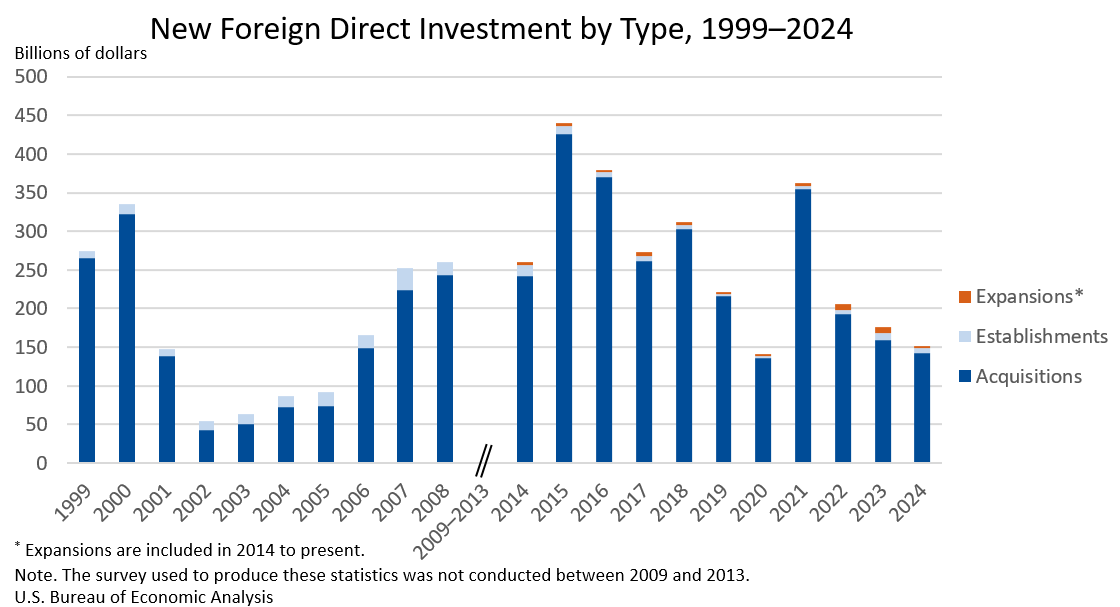Bureau of Economic Analysis
New Foreign Direct Investment in the United States, 2024
Expenditures by foreign direct investors to acquire, establish, or expand U.S. businesses totaled $151.0 billion in 2024, according to preliminary statistics released today by the U.S. Bureau of Economic Analysis. Expenditures decreased $24.9 billion, or 14.2 percent, from $176.0 billion (revised) in 2023 and were below the annual average of $277.2 billion for 2014–2023. As in previous years, acquisitions of existing U.S. businesses accounted for most of the expenditures.
Principal Federal Economic Indicators
Noteworthy
- 2025 News Release Schedule
- Innovation at BEA
- 2025 Annual Updates
- New! Services Trade Data for More Countries
- Data Tool: Trade in Value Added
- Distribution of State Personal Income
- Updated: RIMS II Regional Multipliers
- Arts and Culture
- Space Economy
- FDI Now in State BEARFACTS
- Quick Guide: Price Indexes
The Latest
State Quarterly Personal Income, 2nd quarter 2018
State personal income increased 4.2 percent, at an annual rate, in the second quarter of 2018, a deceleration from the 5.0 percent increase in the first quarter. The percent change in personal income across all states ranged from 6.0 percent in Texas to 1.6 percent in Washington.
Outdoor Recreation Grew Faster Than U.S. Economy in 2016
The outdoor recreation economy accounted for 2.2 percent of current-dollar GDP in 2016, or $412 billion, updated statistics from the Outdoor Recreation Satellite Account show. In data produced for the first time, using inflation-adjusted GDP, the outdoor recreation economy grew 1.7 percent in 2016, faster than the 1.6 percent growth for the overall U.S. economy.
Real gross output, compensation, and employment all grew faster…
Outdoor Recreation Satellite Account: Updated Statistics for 2012-2016
Updated statistics from the Outdoor Recreation Satellite Account (ORSA) released today by the U.S. Department of Commerce’s Bureau of Economic Analysis (BEA) show that the outdoor recreation economy accounted for 2.2 percent ($412 billion) of current-dollar GDP in 2016. In data produced for the first time, using inflation-adjusted (real) GDP, the outdoor recreation economy grew 1.7 percent in 2016, faster than the 1.6 percent growth for the…
U.S. Current-Account Deficit Decreases in Second Quarter 2018
The U.S. current-account deficit decreased to $101.5 billion (preliminary) in the second quarter of 2018 from $121.7 billion (revised) in the first quarter of 2018. As a percentage of U.S. GDP, the deficit decreased to 2.0 percent from 2.4 percent. The previously published current-account deficit for the first quarter was $124.1 billion.
U.S. International Transactions: Second Quarter 2018
The U.S. current-account deficit decreased $20.2 billion to $101.5 billion (preliminary) in the second quarter of 2018.
Gross Domestic Product by Metropolitan Area, 2017
Real gross domestic product (GDP) increased in 312 out of 383 metropolitan areas in 2017. The percent change in real GDP by metropolitan area ranged from 12.1 percent in Odessa, TX to -7.8 percent in Enid, OK.
Coming Soon: An Enhanced Set of Outdoor Recreation Statistics
BEA’s first-ever measurement of the economic power of outdoor recreation, released in February, found that the industry’s contribution to the U.S. economy in 2016 was bigger than other industries like legal services or publishing. Soon people will learn even more about the economic value of outdoor pursuits like canoeing, hunting, RVing, and snowboarding.
July 2018 Trade Gap is $50.1 Billion
The U.S. monthly international trade deficit increased in July 2018 according to the U.S. Bureau of Economic Analysis and the U.S. Census Bureau. The deficit increased from $45.7 billion in June (revised) to $50.1 billion in July, as exports decreased and imports increased. The previously published June deficit was $46.3 billion. The goods deficit increased $4.2 billion in July to $73.1 billion. The services surplus decreased $0.1 billion in…
U.S. International Trade in Goods and Services, July 2018
The U.S. monthly international trade deficit increased in July 2018 according to the U.S. Bureau of Economic Analysis and the U.S. Census Bureau. The deficit increased from $45.7 billion in June (revised) to $50.1 billion in July, as exports decreased and imports increased. The previously published June deficit was $46.3 billion. The goods deficit increased $4.2 billion in July to $73.1 billion. The services surplus decreased $0.1 billion in…




